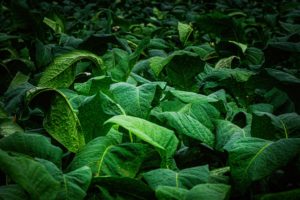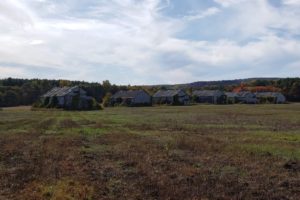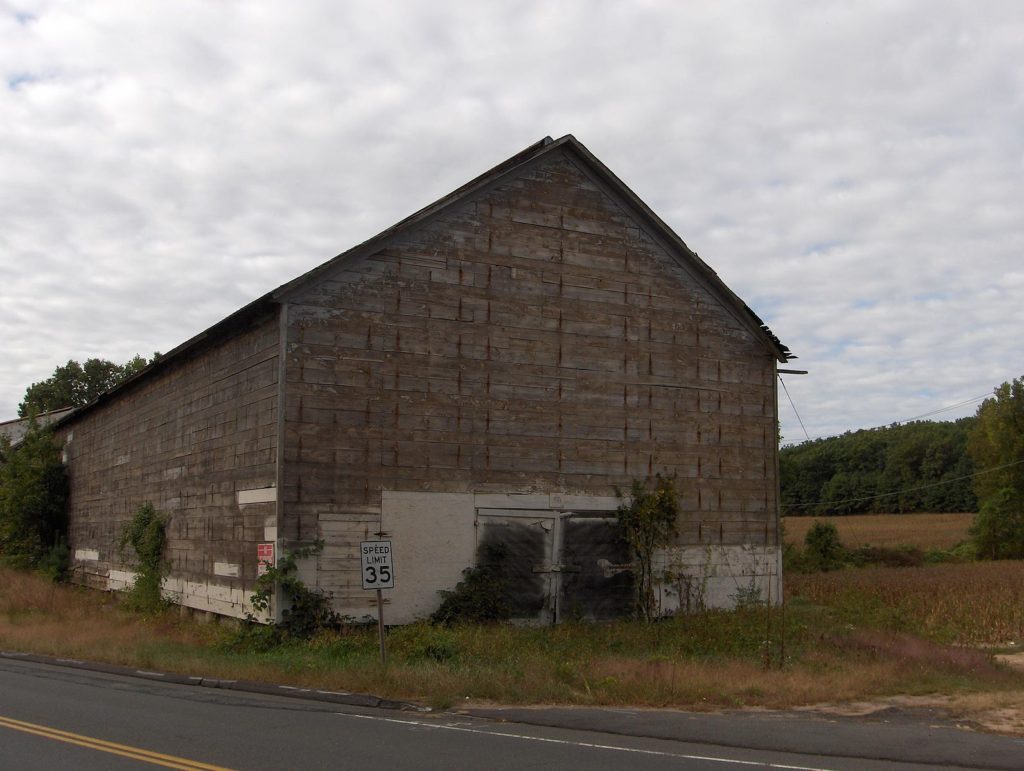By Fiona Vernal
(c) Connecticut Explored Inc., Spring 2023
Subscribe/Buy the Issue!
 Every April, workers from Latin America and the Caribbean—countries like Jamaica, Mexico, and El Salvador and from Puerto Rico—come to New England to work in Connecticut’s Tobacco Valley. Seasonal workers from the New England area will join them, some of them former migrants who have settled in the mainland United States. Their arrival and departure, their comings and goings, will perhaps be noticed by commuters in places like Enfield and Somers, by clinicians who provide health care services to migrant farm workers, state labor monitors, and college faculty who incorporate site visits into their classes as part of doing community-based history and advocacy. But most people in Connecticut, even in the local towns where tobacco is grown, will largely miss the rhythms of the season and the legions of workers without whom the industry would fail.
Every April, workers from Latin America and the Caribbean—countries like Jamaica, Mexico, and El Salvador and from Puerto Rico—come to New England to work in Connecticut’s Tobacco Valley. Seasonal workers from the New England area will join them, some of them former migrants who have settled in the mainland United States. Their arrival and departure, their comings and goings, will perhaps be noticed by commuters in places like Enfield and Somers, by clinicians who provide health care services to migrant farm workers, state labor monitors, and college faculty who incorporate site visits into their classes as part of doing community-based history and advocacy. But most people in Connecticut, even in the local towns where tobacco is grown, will largely miss the rhythms of the season and the legions of workers without whom the industry would fail.
This invisibility is one of the many themes explored in Shade: Labor Diasporas, Tobacco, Mobility, and Urbanization, a new exhibition opening in June 2023 at the Hartford History Center, Hartford Public Library. Shade is the brainchild of three Connecticut-based historians and curators, Dr. Fiona Vernal and Dr. Jason Oliver Chang, historians based at the University of Connecticut; and Elena Marie Rosario, a Ph.D. candidate at the University of Michigan. The scholars will use their expertise in African American, Puerto Rican, and Asian and Asian American Studies to explore how shade tobacco has shaped the disparate lives and communities that have made shade tobacco production successful and profitable.
Against the backdrop of invisibility is another story about the ubiquity of tobacco labor. As youth college, and summer laborers, for example, many Connecticut residents have done a stint working in tobacco. Labor recruitment in the Northeast and Southern United States also brought both youth and adult seasonal workers to Connecticut. When viewed in tandem with the history of labor recruitment in Latin America and the Caribbean, it is clear that shade tobacco has generated a massive labor pool with overlapping experiences. Yet this swath of collective experiences, though documented, is not usually told as a collective history. The exhibition is one attempt to craft a collective and inclusive narrative examining the shade-tobacco industry using the themes of labor, diaspora, and community formation as both a mirror and a lens.
Issues of preservation, open land, and the pressures of development have been featured in local and national news coverage as one tobacco shed after another disappears, and land is sold to commercial developers. The Trust for Public Land and the Town of Simsbury has worked to preserve part of the farm where Dr. Martin Luther King Jr. did his stints as a tobacco worker when he was 15 and 18. From The New York Times and The Hartford Courant to Fox 61 News and NBC Connecticut, recent news reports of Dr. King’s experiences have added to public awareness of the reach and ubiquity of tobacco’s shade industry. Simsbury High School students created an important monument commemorating Dr. King’s work, his time in Connecticut, and the legacy of his quest for equality and freedom. [See “Game Changer: Summers of Freedom: Martin Luther King Jr. in Connecticut,” Winter 2022-2023.} Simsbury serves as one model of youth engagement with public history and of a local town engaging its connections to the past. Eastern Connecticut State University’s theater department is working on a documentary exploring the contributions of the workers who made this industry possible. This follows on last year’s theatrical production, Cultivating Dignity by professors Alycia Bright-Holland and Kristen Morgan, which also explored Dr. King’s time in Simsbury.
Shade: Labor Diasporas, Tobacco, Mobility, and Urbanization weaves these disparate threads into a new account. Its premise is that the Connecticut River Valley, spanning several small New England states, has a long history of interconnections with the global economy. From its indigenous inhabitants, labor diasporas, and settlement of European colonists to the whaling industry and maritime commercial links to slavery and the slave trade, this region has been embedded in a global network since the 16th century. Despite these global connections, New England in general, and the Connecticut Valley in particular, has often been characterized as a white parochial and culturally static place, perspectives countered by a diverse and interdisciplinary scholarship from history, architecture, and museum studies. These include the scholarship of Jean Stubbs, James F. O’Gorman, and Brianna Dunlap. Casting Connecticut as “the land of steady habits” elides some of the histories of migration that brought people from all over the world to work.
Tobacco cultivation is the setting for one of the most egregious acts of erasure. Plagued by labor bottlenecks for netting, weeding, and harvesting since production began in the 17th century, tobacco has always been a labor-intensive industry capitalizing on the ebb and flow of U.S. immigration and labor policies. Its cultivation reveals key intersections of U.S. imperial, labor, and immigration history that have been addressed in an uneven fashion in scholarly and popular literature. The vision for the exhibition exceeds the capacity of any one historian to fully express it. A collaborative approach will permit an exploration of the local, regional, national, and global reverberations of the valley’s tobacco industry.
The agricultural segment of the tobacco industry has played a pivotal, and often foundational, role in generating Black and Latino labor diasporas and shaping global commodity markets. Some people’s labor experiences drew on tobacco cultivation experiences in Georgia, Virginia, or Puerto Rico, while others had a novel experience. For many, it was a bridge to nascent diasporas, a place where cultural others jostled in the fields and barns. Sometimes you found a wife, a lover, a friend, or a new social network. Alongside this mélange of stories are flattened narratives of how many local teenagers took a turn at summer or seasonal labor in the tobacco fields—commonplace local narratives that hide the systemic reliance on deportable, seasonal, and migrant labor to maximize price ceilings for a boutique crop used for cigar wrappers.
The exhibition posits that the framework of diasporas is a capacious lens through which to integrate stories of tobacco growers into the collective model the narrative proposes. Often told as a tale of white ingenuity, the story of shade tobacco typically overlooks the story of growers versus workers, which is embedded in false or incomplete narratives that do little to capture the relationships, compromises, and negotiations that has given shade tobacco its longevity. This is the kind of intellectual lens that can account for the histories of three generations of Polish American tobacco farming, for example, with multigenerational traditions of seasonal migration, and for the creation of new diasporic communities of Puerto Ricans, African Americans, and West Indians. This is the kind of cultural lens that can also assess how tobacco, including both labor in broadleaf and shade, influenced other communities. Southeast Asians in the Greater Hartford region, for example, may not recount this tobacco labor experience as constitutive, yet it has shaped the consciousness of some individuals. Nowhere is this more evident than in Ocean Vuong’s 2019 novel On Earth We’re Briefly Gorgeous, which, drawing on Vuong’s own experiences, recounts his summers working in tobacco when he was a 14-year-old Vietnamese American encountering a diverse range of seasonal workers (Vuong, 85-91).
 Ubiquity is a thing of the past. Child labor legislation and changes in perceptions about what constitutes appropriate labor for youth and women have shifted the makeup of the tobacco labor force. The work now is relegated almost exclusively to seasonal migrant farm workers. What is not a thing of the past is the invisibility of these men. As long as remittances continue to play a key role in the economic strategies of Caribbean and Latin American nationals, the shade tobacco industry will continue to draw on migrant farm labor programs.
Ubiquity is a thing of the past. Child labor legislation and changes in perceptions about what constitutes appropriate labor for youth and women have shifted the makeup of the tobacco labor force. The work now is relegated almost exclusively to seasonal migrant farm workers. What is not a thing of the past is the invisibility of these men. As long as remittances continue to play a key role in the economic strategies of Caribbean and Latin American nationals, the shade tobacco industry will continue to draw on migrant farm labor programs.
 But new and different questions loom. Will shade tobacco be around for another generation? Will labor costs make it far more profitable to produce the crop in the Caribbean with cheap labor, as current trends suggest? The answers to these questions lie in the global flows of capital and the increasing market share that central American countries capture by competing on labor while capitalizing on marketing Connecticut seed. As warehouses and logistics hubs increasingly dot the contemporary suburban landscape, some on former tobacco land, history reminds us that commercial land use has displaced farm land in many other instances. In an earlier era of commercial development, tobacco land gave way to hotels, shopping malls, schools, and other residential developments. Shade: Labor Diasporas, Tobacco, Mobility, and Urbanization provides an opportunity to pause at this inflection point, to address the former ubiquity of the crop, the generation of farmers who ushered in this industry, and the invisibility of its workers. The exhibition will travel to other locations, with Luddy/Taylor Connecticut Valley Tobacco Museum and the Windsor Historical Society as key sites and partners.
But new and different questions loom. Will shade tobacco be around for another generation? Will labor costs make it far more profitable to produce the crop in the Caribbean with cheap labor, as current trends suggest? The answers to these questions lie in the global flows of capital and the increasing market share that central American countries capture by competing on labor while capitalizing on marketing Connecticut seed. As warehouses and logistics hubs increasingly dot the contemporary suburban landscape, some on former tobacco land, history reminds us that commercial land use has displaced farm land in many other instances. In an earlier era of commercial development, tobacco land gave way to hotels, shopping malls, schools, and other residential developments. Shade: Labor Diasporas, Tobacco, Mobility, and Urbanization provides an opportunity to pause at this inflection point, to address the former ubiquity of the crop, the generation of farmers who ushered in this industry, and the invisibility of its workers. The exhibition will travel to other locations, with Luddy/Taylor Connecticut Valley Tobacco Museum and the Windsor Historical Society as key sites and partners.
Fiona Vernal is Associate Professor of History and Africana Studies at the University of Connecticut.
_____

